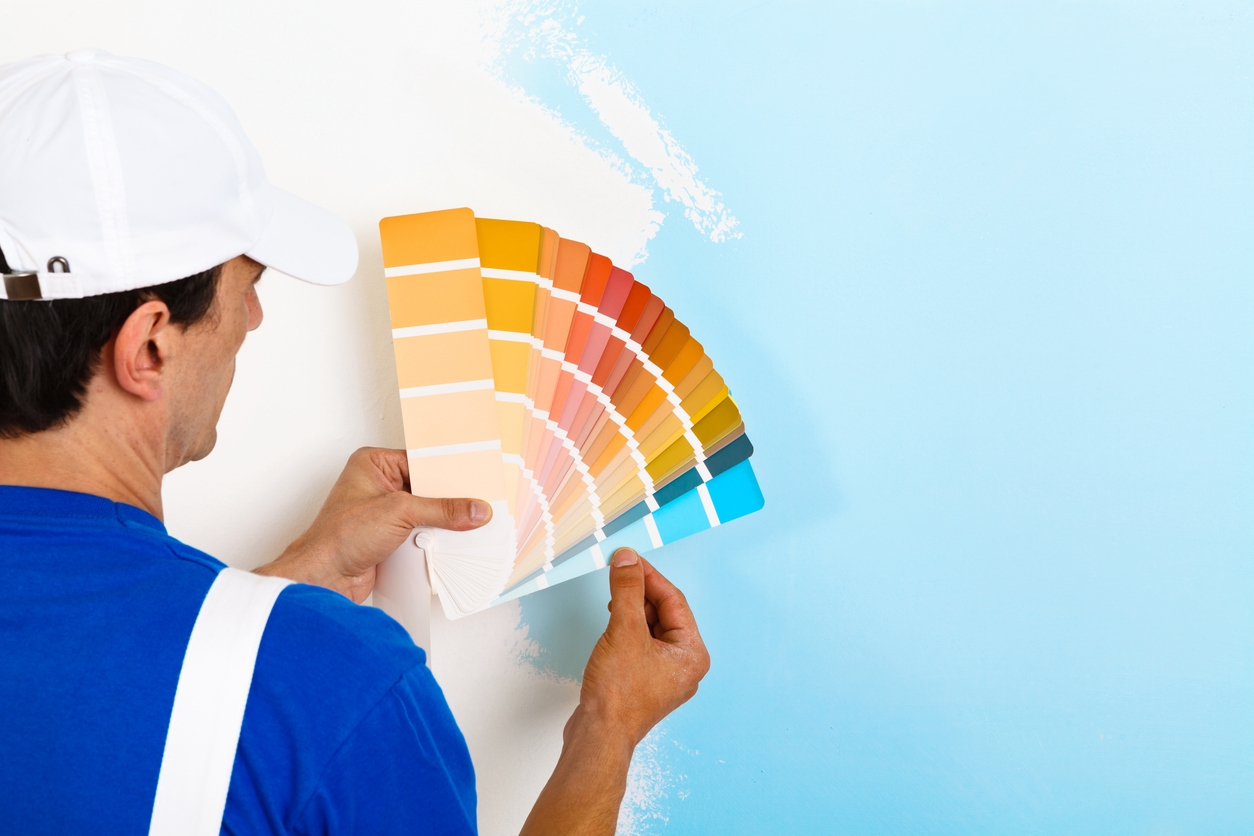Knowing the basics is crucial in a Fremont area home or commercial painting project. Whether choosing the DIY route or hiring a contractor, consider several key factors, such as selecting the correct color and shade, paint finish, and the number of coats to be applied.
Applying multiple coats of paint is crucial for durability and appearance, ensuring a smooth, even finish that withstands wear over time. A single paint coat often isn’t enough because it may leave streaks, uneven coverage, and insufficient protection, especially for high-traffic areas. This can be especially true when performing painting aluminum and vinyl siding projects.
Multiple coats are important when making drastic color changes, covering dark or bright shades, or painting surfaces exposed to frequent use, as they enhance color depth and provide a longer-lasting, professional finish.
When multiple coats are necessary
Here are some of the ways to know when you need to apply multiple coats of paint:
- Drastic color changes: Transitioning from dark to light colors, or vice versa, often requires multiple coats to hide the previous shade and achieve an even, true color. Darker shades can bleed through lighter colors, making several layers essential.
- New walls or unpainted surfaces: Raw surfaces like drywall or bare wood absorb paint unevenly, so multiple coats are necessary to ensure proper coverage, smoothness, and longevity. Priming first can help, but a second or third coat is often still needed.
- High-traffic areas: In areas like hallways or commercial spaces, where walls are subject to wear and tear, extra coats provide a thicker, more durable finish, helping resist scuffs, scratches, and frequent cleaning.
- Using bright or bold colors: Bright or bold colors, especially reds, yellows, and deep blues, often require more than one coat for full vibrancy and even application, as these pigments tend to be less opaque. Multiple layers help achieve a consistent, striking look.
Choosing the right primer
- Importance of priming: Primer helps create a smooth, even surface for paint application, enhancing paint adhesion and longevity. It is crucial when painting over stains, uneven textures, or drastically changing colors, as it seals the surface and prevents imperfections from showing through the final coat.
- Tinting the primer: Tinting the primer to match or complement the paint color closely can reduce the number of topcoats needed. It helps with coverage, particularly when transitioning from a dark to a light color or vice-versa, saving time and paint.
- When to use multiple priming coats: Multiple coats of primer may be required on porous surfaces, like raw wood or new drywall, which absorb primer unevenly. These surfaces need extra sealing to create a consistent foundation for the paint.
How many coats are ideal?
Standard recommendation
Typically, two coats of paint are sufficient for achieving a professional finish for homes and businesses in San Jose. The first coat provides coverage, and the second coat ensures evenness, durability, and depth of color.
Three or more coats
In some cases, three or more coats are recommended, especially when covering a high-contrast color (e.g., going from dark to light), using deep, saturated colors, or painting rough or porous surfaces like textured walls or bare wood. Additional coats help prevent streaking and uneven coverage.
Factors that influence the number of coats
- Surface texture: Rough, porous surfaces often need more coats for smooth coverage.
- Paint color: Dark or bold colors may require more coats for full opacity, particularly over a contrasting base.
- Paint type: Matte finishes require more coats than glossy finishes, which tend to offer better coverage per coat.
Paint type and its role in coverage
Quality of paint
Higher-quality paints generally contain more pigments and binders, which provide better coverage and color consistency. They often require fewer coats to achieve a uniform finish, saving time and effort. Premium paints also tend to last longer and resist fading, ensuring a more durable result.
Finish matters
The type of finish can impact the number of coats needed. Flat or matte finishes offer better coverage with fewer coats but can be less durable in high-traffic areas. Satin and semi-gloss finishes may require additional coats to achieve a smooth, even look, especially if you want a more reflective or polished surface. These finishes, however, are more resistant to wear and easier to clean.
Self-priming paints
Self-priming paints combine primer and paint in one product, potentially reducing the need for separate primer coats. They are beneficial for surfaces that are already in good condition. However, for rough or porous surfaces, traditional priming followed by painting offers better adhesion and coverage. Self-priming paints can be a time-saver but may not always provide the best results in challenging conditions.
Drying time between coats
- Why drying time matters: Allowing each coat of paint to fully dry is crucial for a smooth, durable finish. If you don’t give enough time between coats, it can lead to issues like bubbling, peeling, or an uneven texture. Proper drying ensures better adhesion, coverage, and longevity of the paint job.
- Recommended drying times: Drying times vary by paint type.
- For latex (water-based) paint, you should wait 2-4 hours between coats.
- For oil-based paint, it typically requires 6-8 hours or more. Environmental factors like humidity and temperature can extend drying time; lower temperatures and higher humidity slow the process.
- Consequences of rushing: Rushing through coats without letting the paint fully dry can lead to problems like streaks, uneven coverage, or poor adhesion. It often results in needing more touch-ups or, in severe cases, redoing the paint job entirely.
Application techniques for better coverage
The following techniques contribute to a smoother, more professional-looking finish with even coverage.
1. Rolling vs. brushing
- Rollers are best for large, flat surfaces. They offer smooth, even coverage and reduce application time. Use the appropriate roller nap for the surface texture—short naps for smooth surfaces and longer naps for rougher ones.
- Brushes are ideal for detailed work, edges, and trim. When using a brush, apply paint with long, smooth strokes and feather the edges to blend seamlessly.
- Best practices: Avoid pressing too hard with either tool. Rollers should be used in a “W” or “M” pattern, then filled in, while brushing should be done with light, overlapping strokes to prevent streaks.
2. Maintaining a wet edge
- Keeping a wet edge ensures that newly applied paint blends smoothly into the previous section, preventing visible lap lines and uneven drying patches.
- Always work in small sections, and never allow the edge of the painted area to dry before adding more paint.
3. Proper loading of tools
- Rollers: Load evenly by rolling in the tray multiple times, ensuring the roller is saturated but not dripping. Doing so prevents over-application, which leads to drips and uneven surfaces.
- Brushes: Dip the brush about one-third into the paint and tap off excess rather than wiping it along the rim. It allows for controlled application and minimizes splatter or thin patches.
Dealing with paint buildup and uneven surfaces
- Sanding between coats: Light sanding between coats is essential for achieving a smoother finish and improving paint adhesion. It helps eliminate rough patches, dust particles, and imperfections from the previous coat, ensuring the next layer adheres better and results in a more polished look. Use fine-grit sandpaper (around 220) for this step, followed by a thorough cleaning to remove sanding dust.
- Avoiding drips and streaks: To prevent paint drips and streaks, apply thin, even layers of paint. Use a high-quality brush or roller and avoid overloading them with paint. Work in manageable sections and maintain consistent pressure. Keeping a wet edge—where the paint from one section overlaps with the next—helps ensure an even finish.
- Fixing imperfections: After each coat, inspect the surface for minor imperfections, like bubbles, streaks, or dried drips. Sand or scrape away any problem areas before applying the next coat. A light touch-up with a brush or roller can also help correct minor flaws before proceeding with additional layers.
Environmental factors that affect coats
Environmental factors are significant in how well paint coats adhere and dry. Here’s how temperature, humidity, ventilation, and lighting affect the painting process:
- Temperature and humidity: High humidity slows down drying times, as moisture in the air prevents the paint from curing correctly, which may require more time between coats or additional coats for full coverage. Extreme temperatures, whether too hot or too cold, can affect paint consistency, leading to uneven application or cracking.
- Ventilation: Good airflow is essential for proper drying. Without adequate ventilation, moisture can get trapped, leading to issues like blistering or peeling. Proper ventilation helps ensure even drying and reduces the chance of dampness affecting the paint finish.
- Lighting conditions: Lighting, whether natural or artificial, can expose imperfections in the paint job. Under specific lighting, you may notice inconsistencies like streaks or thin spots, requiring extra coats to achieve an even, professional finish.
Cost considerations for multiple coats
When considering several coats of paint, here are the main cost factors:
- Material costs: Applying multiple coats increases the total paint amount needed, directly raising material costs. Each additional coat means more gallons of paint, primers, and other materials like rollers or brushes.
- Labor time: In commercial painting jobs, each coat takes time to apply and dry, extending the project timeline. This results in higher labor costs, as workers spend more hours on the job for every added coat.
- Saving costs with proper planning: Proper surface preparation, such as cleaning and priming, can ensure better adhesion and coverage, reducing the number of coats needed. Additionally, choosing high-quality paint with better coverage can cut down on coats, ultimately saving time and money.
The role of a professional painter
When it comes to achieving the ideal paint coating and coverage, the role of a professional painter is invaluable. Their expertise, efficiency, and custom recommendations ensure a high-quality finish that enhances the appearance and longevity of your surfaces.
- Expertise in coverage and coating: Professional painters can determine when multiple coats are necessary based on surface conditions, paint types, and desired finishes. Their experience helps them identify areas needing extra attention, ensuring a uniform and flawless appearance.
- Efficiency and quality: Hiring a professional guarantees that multiple coats are applied systematically and effectively, minimizing waste of materials and time. They follow established techniques to ensure each layer adheres correctly, leading to a durable and long-lasting finish.
- Custom recommendations: Professionals assess the specific characteristics of each surface, offering tailored advice on the best coating methods and products. This customization ensures optimal results for each project, considering factors like texture, color, and environmental conditions.
Conclusion
When applying multiple coats of paint, consider proper priming, selecting the right paint, allowing adequate drying time, and using the correct techniques. These factors are essential in achieving the perfect coverage, resulting in a smooth, flawless, and long-lasting paint finish.
For expert advice and professional painting services that ensure a smooth, durable finish with the correct number of coats, contact Custom Painting, Inc. today at 925-866-9610 or on our contact page for a free consultation and estimate.




